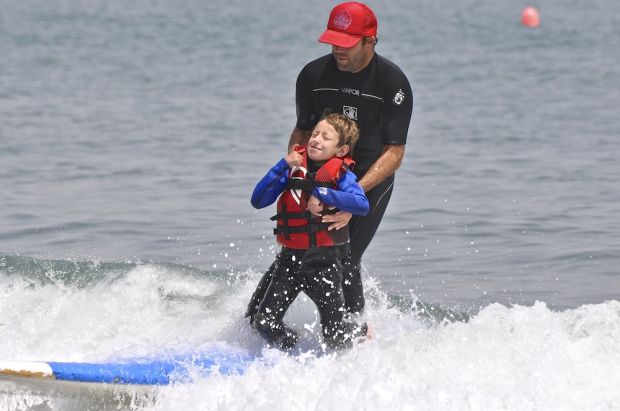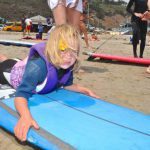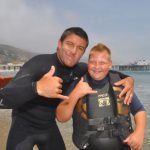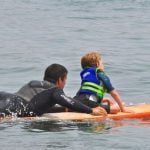
Surf culture has been a part of Malibu almost since the town was established nearly a century ago. Surfing is still a defining local pastime, but one Malibu couple is using surfing as therapy for children who might not otherwise ever get on a board.
Kim Bordenvave Gamboa and her husband, Jimmy, launched THERAsurf a few years ago, after Kim’s son James was diagnosed with Angelman Syndrome, a neuro-genetic disorder that causes severe intellectual and developmental disabilities. Much like some people on the autism spectrum, Angelman patients frequently are nonverbal, have seizures, and generally have movement and balance impairment. There is no cure.
“I was a single mom at the time,” Kim said. “But I wasn’t going to just let James sit around. I knew he needed stimulation, so we went to the beach and he loved it. That’s where I met Jimmy.”
James, now 10 years old, and Jimmy bonded when the two would go out surfing. Jimmy helped James to balance on the board. Kim noticed the calm and confidence exuding from her son when they returned from the water.
She started to wonder if other children with developmental disabilities could benefit similarly from surfing.
“When James first started surfing with Jimmy, he couldn’t really walk well,” Kim said. “That began to change as he found a balance on the board. Kids with Angelman have a thing with their vestibular ear that translates balance to the brain and eye. With surfing, you’re moving in space in a different way and it affects their whole sense of motion.”
Kim noticed how well Jimmy, a longtime surfing local, communicated with James. She said he seemed to have an intuitive knowledge of how afflicted children’s bodies worked and how to encourage fine motor skills.
Families with children dealing with developmental disabilities form a small, but fiercely supportive community. Kim’s friends have children with cerebral palsy, autism, epilepsy, traumatic brain injuries and Down syndrome. She says it makes it difficult to “relate” to families with normal kids. But James’ success in surfing with Jimmy gave Kim hope that there was a path toward normalcy right out on the beach.
Jimmy started to take other challenged children out on the board. He rounded up some surfing buddies—many of them firemen and lifeguards—to help. Kim said that when the kids returned to shore, they were different.
“I began to see such joy in their faces,” she said. “The happiness at their accomplishment is palpable. Their parents are in tears. For me, to see the surfing community connect with the special needs community is very special.”
Soon Jimmy started lining up local sponsors to help defray costs (for purchase of Coast Guard-approved life vests, boards, wet suits, insurance, etc). Duke’s Restaurant came on board. Val Surf and Freedom Artists helped get THERAsurf an invitation to the “Call to the Wall” surf contest. Word of mouth spread, and more parents started lining up with children for whom just walking on the beach was a challenge.
“My surfing buddies are all guys I went to school with,” Jimmy said. “They’re good water men and I trust them. It’s tough sometimes for guys to show such compassion but these guys are amazing. We have a beautiful community.”
THERAsurf signs up children for about eight surf sessions a summer, providing a wetsuit, life vest, transition time to work with a surfing “buddy” and an unforgettable afternoon in the water.
THERAsurf ’s team is sensitive to all the children’s needs. They’ll spend time with each child, allowing him or her to get used to the sensory changes—the tidal flow, the tipping of the board and the sense of speed— before catching a wave and helping the child to stand (if possible) and ride. Inevitably, the child returns to shore with a huge smile and wordless, but unmistakable, enthusiasm for the experience.
Kim and Dwayne Sinclair of Redondo Beach have been attending THERAsurf sessions with their son for about three years. Ryan, 10, has cerebral palsy and has difficulty standing or speaking. But his passion for his surfing outings is infectious. His parents could barely help him out of his wetsuit, he was so keen on the excitement of his runs.
“There is a real focus on safety and the children’s full experience,” Kim Sinclair said. “This is a huge challenge for Ryan and he meets it. So it’s a bridge to typical children that we can incorporate into his other therapies.”
The Gamboas have held THERAsurf camps in Maui and Sayulita, Mexico. They want to take a team to Biarritz, France when the funding comes through. They know that children all over the world can benefit from surfing.
“For me, it’s that bridge to normalcy that matters most,” Dwayne Sinclair said. “People who see Ryan surfing see his achievement, not his disability.”
For more information on THERAsurf, visit www.therasurf.org.



